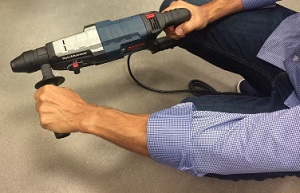Because power tools are so commonly used, workers are constantly exposed to a variety of hazards. The very tool that makes tasks easier and more efficient may one day be the cause of a tragic injury. It is good to be reminded of common-sense safety practices when it comes to using electrical tools on the job.

Workers should be trained in the proper use of all electrical tools they may be required to use. Workers should also be able to recognize the hazards associated with the different types of power tools and take all the safety precautions necessary.
OSHA General Industry Standard 1910.242(a) Each employer shall be responsible for the safe condition of tools and equipment used by employees, including tools and equipment which may be furnished by employees.
Electrical Tools Safety Rules
The basic rules for using electrical tools safely include:
- Use the right tool for the job.
- Inspect each tool for damage before use.
- Keep all tools in good condition with regular maintenance.
- Operate tools according to the manufacturer’s instructions.
- Wear the proper personal protective equipment (PPE).
- Never use a damaged tool. Take damaged tools out of service immediately.
OSHA Construction Standard 1926.300(a) All hand and power tools and similar equipment, whether furnished by the employer or the employee, shall be maintained in a safe condition.
Additional safety precautions to remember:
- Keep everyone not involved in the work at a safe distance from the work area.
- Never carry a tool by the cord.
- Never yank the cord to disconnect it from the outlet.
- Keep cords away from heat, oil, and sharp edges.
- Store electric tools in a dry place when not in use.

Personal Protective Equipment
Employees who use electrical tools and are exposed to the hazards of falling, flying, abrasive, and splashing objects, or to harmful dusts, fumes, mists, vapors, or gases must select and wear appropriate personal protective equipment (PPE).
Eye protection, such as safety glasses or goggles, is especially important when using electrical tools. Others working in the area where electrical tools are being used should also wear eye protection.
During certain tasks, such as when working with grinders, a face shield may also be suggested to be worn over the eye protection. When worn alone, face shields do not protect employees from impact hazards. Use face shields in combination with safety glasses or goggles, even in the absence of dust or potential splashes, for additional protection beyond that offered by safety glasses or goggles alone.
Standard cotton or leather work gloves can protect hands from minor scrapes and cuts, but keep in mind that even cut-resistant gloves are not capable of providing protection against a moving blade or bit.
Safety footwear with a non-slip, electrically insulated sole and a protective toe cap can protect against dropped objects and misdirected electricity.
Depending on the tools and materials, some tasks may require hearing protection, like ear plugs or earmuffs, or even respiratory protection.

Electrical Tool Hazards
In addition to injuries like lacerations, amputations and eye trauma, workers using electrical tools are at a greater risk for even more serious hazards like electrical burns, shocks, and falls due to shocks.
Double-Insulated Electrical Tools
To protect the user, electrical tools must have 1) a three-wire cord with a ground and be plugged into a grounded receptacle, OR 2) be double-insulated, OR 3) be powered by a low voltage isolation transformer.
Double-insulated tools are generally recommended as they provide an internal layer of protective insulation that completely isolates the external housing of the tool. Look for the words indicating a tool is “Double Insulated” or the double square symbol to confirm a tool has a double insulated safety design.
All electrical connections for electrical tools must be suitable for the type of tool and the working conditions (wet, dusty, flammable vapors). When a temporary power source is used for construction a ground-fault circuit interrupter should be used. Disconnect tools when not in use, before servicing, when cleaning and when changing accessories such as blades, bits, cutters, etc. Do not use electric tools in damp or wet locations unless they are approved for that purpose.

Injury Prevention
The best way to prevent injuries from the high-speed hazards of electrical tools is to always keep your hands on the handles of the tools and keep all guards in place. Never remove or alter safety guards on an electrical tool.
OSHA Construction Standard 1926.300(b)(1) When power operated tools are designed to accommodate guards, they shall be equipped with such guards when in use.
Be sure to keep good footing and maintain good balance when operating power tools. Avoid accidental starting. Do not hold fingers on the switch button while carrying a plugged-in tool. Keep work areas well lighted when operating electric tools. Wear proper apparel for the task. Loose clothing, ties, and jewelry can become caught in moving parts.
OSHA General Industry Standard 1910.243(a)(2)(iv) The operating control on hand-held power tools shall be so located as to minimize the possibility of its accidental operation, if such accidental operation would constitute a hazard to employees.
Extension Cords
When extension cords are used with electrical power tools, they introduce additional hazards to the work area. Extension cords can become damaged if they are not taken care of with damage occurring to the insulation of the cord, exposing energized conductors.
When a worker handling a damaged extension cord touches exposed wires while holding a metal tool case or contacting a conductive surface, serious electrical shock can result, causing a fall, physical injury, or death. Ensure that cords from electric tools, as well as extension cords, do not present a tripping hazard.

.jpeg)

.jpeg)